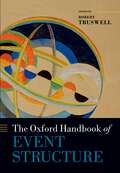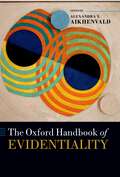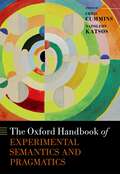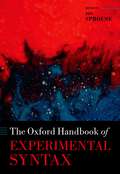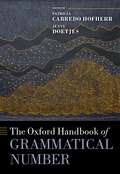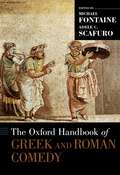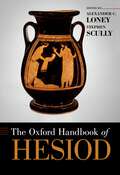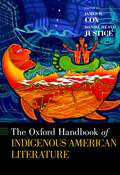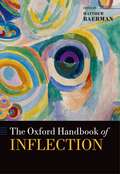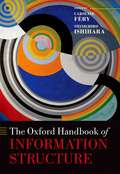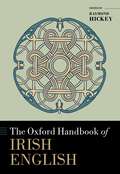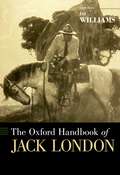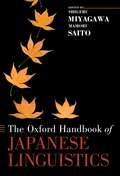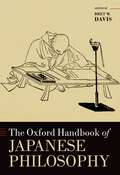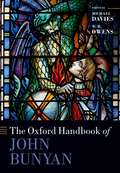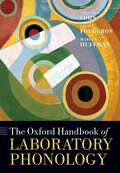- Table View
- List View
The Oxford Handbook of Event Structure (Oxford Handbooks)
This handbook deals with research into the nature of events, and how we use language to describe events. The study of event structure over the past 60 years has been one of the most successful areas of lexical semantics, uniting insights from morphology and syntax, lexical and compositional semantics, cognitive science, and artificial intelligence to develop insightful theories of events and event descriptions. This volume provides accessible introductions to major topics and ongoing debates in event structure research, exploring what events are, how we perceive them, how we reason with them, and the role they play in the organization of grammar and discourse. The chapters are divided into four parts: the first covers metaphysical issues related to events; the second is concerned with the relationship between event structure and grammar; the third is a series of crosslinguistic case studies; and the fourth deals with links to cognitive science and artificial intelligence more broadly. The book is strongly interdisciplinary in nature, with insights from linguistics, philosophy, psychology, cognitive science, and computer science, and will appeal to a wide range of researchers and students from advanced undergraduate level upwards.
The Oxford Handbook of Evidentiality (Oxford Handbooks)
by Alexandra Y. AikhenvaldThis volume offers a thorough, systematic, and crosslinguistic account of evidentiality, the linguistic encoding of the source of information on which a statement is based. In some languages, the speaker always has to specify this source - for example whether they saw the event, heard it, inferred it based on visual evidence or common sense, or was told about it by someone else. While not all languages have obligatory marking of this type, every language has ways of referring to information source and associated epistemological meanings. The continuum of epistemological expressions covers a range of devices from the lexical means in familiar European languages and in many languages of Aboriginal Australia to the highly grammaticalized systems in Amazonia or North America. In this handbook, experts from a variety of fields explore topics such as the relationship between evidentials and epistemic modality, contact-induced changes in evidential systems, the acquisition of evidentials, and formal semantic theories of evidentiality. The book also contains detailed case studies of evidentiality in language families across the world, including Algonquian, Korean, Nakh-Dagestanian, Nambikwara, Turkic, Uralic, and Uto-Aztecan.
The Oxford Handbook of Evidentiality (Oxford Handbooks)
This volume offers a thorough, systematic, and crosslinguistic account of evidentiality, the linguistic encoding of the source of information on which a statement is based. In some languages, the speaker always has to specify this source - for example whether they saw the event, heard it, inferred it based on visual evidence or common sense, or was told about it by someone else. While not all languages have obligatory marking of this type, every language has ways of referring to information source and associated epistemological meanings. The continuum of epistemological expressions covers a range of devices from the lexical means in familiar European languages and in many languages of Aboriginal Australia to the highly grammaticalized systems in Amazonia or North America. In this handbook, experts from a variety of fields explore topics such as the relationship between evidentials and epistemic modality, contact-induced changes in evidential systems, the acquisition of evidentials, and formal semantic theories of evidentiality. The book also contains detailed case studies of evidentiality in language families across the world, including Algonquian, Korean, Nakh-Dagestanian, Nambikwara, Turkic, Uralic, and Uto-Aztecan.
The Oxford Handbook of Experimental Semantics and Pragmatics (Oxford Handbooks)
by Chris Cummins Napoleon KatsosThis handbook is the first to explore the growing field of experimental semantics and pragmatics. In the past 20 years, experimental data has become a major source of evidence for building theories of language meaning and use, encompassing a wide range of topics and methods. Following an introduction from the editors, the chapters in this volume offer an up-to-date account of research in the field spanning 31 different topics, including scalar implicatures, presuppositions, counterfactuals, quantification, metaphor, prosody, and politeness, as well as exploring how and why a particular experimental method is suitable for addressing a given theoretical debate. The volume's forward-looking approach also seeks to actively identify questions and methods that could be fruitfully combined in future experimental research. Written in a clear and accessible style, this handbook will appeal to students and scholars from advanced undergraduate level upwards in a range of fields, including semantics and pragmatics, philosophy of language, psycholinguistics, computational linguistics, cognitive science, and neuroscience.
The Oxford Handbook of Experimental Semantics and Pragmatics (Oxford Handbooks)
This handbook is the first to explore the growing field of experimental semantics and pragmatics. In the past 20 years, experimental data has become a major source of evidence for building theories of language meaning and use, encompassing a wide range of topics and methods. Following an introduction from the editors, the chapters in this volume offer an up-to-date account of research in the field spanning 31 different topics, including scalar implicatures, presuppositions, counterfactuals, quantification, metaphor, prosody, and politeness, as well as exploring how and why a particular experimental method is suitable for addressing a given theoretical debate. The volume's forward-looking approach also seeks to actively identify questions and methods that could be fruitfully combined in future experimental research. Written in a clear and accessible style, this handbook will appeal to students and scholars from advanced undergraduate level upwards in a range of fields, including semantics and pragmatics, philosophy of language, psycholinguistics, computational linguistics, cognitive science, and neuroscience.
The Oxford Handbook of Experimental Syntax (Oxford Handbooks)
by Jon SprouseThis volume showcases the contributions that formal experimental methods can make to syntactic research in the 21st century. Syntactic theory is both a domain of study in its own right, and one component of an integrated theory of the cognitive neuroscience of language. It provides a theory of the mediation between sound and meaning, a theory of the representations constructed during sentence processing, and a theory of the end-state for language acquisition. Given the highly interactive nature of the theory of syntax, this volume defines "experimental syntax" in the broadest possible terms, exploring both formal experimental methods that have been part of the domain of syntax since its inception (i.e., acceptability judgment methods) and formal experimental methods that have arisen through the interaction of syntactic theory with the domains of acquisition, psycholinguistics, and neurolinguistics. The Oxford Handbook of Experimental Syntax brings these methods together into a single experimental syntax volume for the first time, providing high-level reviews of major experimental work, offering guidance for researchers looking to incorporate these diverse methods into their own work, and inspiring new research that will push the boundaries of the theory of syntax. It will appeal to students and scholars from the advanced undergraduate level upwards in a range of fields including syntax, acquisition, psycholinguistics, neurolinguistics, and computational linguistics.
The Oxford Handbook of Experimental Syntax (Oxford Handbooks)
This volume showcases the contributions that formal experimental methods can make to syntactic research in the 21st century. Syntactic theory is both a domain of study in its own right, and one component of an integrated theory of the cognitive neuroscience of language. It provides a theory of the mediation between sound and meaning, a theory of the representations constructed during sentence processing, and a theory of the end-state for language acquisition. Given the highly interactive nature of the theory of syntax, this volume defines "experimental syntax" in the broadest possible terms, exploring both formal experimental methods that have been part of the domain of syntax since its inception (i.e., acceptability judgment methods) and formal experimental methods that have arisen through the interaction of syntactic theory with the domains of acquisition, psycholinguistics, and neurolinguistics. The Oxford Handbook of Experimental Syntax brings these methods together into a single experimental syntax volume for the first time, providing high-level reviews of major experimental work, offering guidance for researchers looking to incorporate these diverse methods into their own work, and inspiring new research that will push the boundaries of the theory of syntax. It will appeal to students and scholars from the advanced undergraduate level upwards in a range of fields including syntax, acquisition, psycholinguistics, neurolinguistics, and computational linguistics.
The Oxford Handbook of Grammatical Number (Oxford Handbooks)
by Patricia Cabredo Hofherr Jenny DoetjesThis volume offers detailed accounts of current research in grammatical number in language. Following a detailed introduction, the chapters in the first three parts of the book explore the multiple research questions in the field and the complex problems surrounding the analysis of grammatical number: Part I presents the background and foundational notions, Part II the morphological, semantic, and syntactic aspects, and Part III the different means of expressing plurality in the event domain. The final part offers fifteen case studies that include in-depth discussion of grammatical number phenomena in a range of typologically diverse languages, written by - or in collaboration with - native speakers linguists or based on extensive fieldwork. The volume draws on work from a range of subdisciplines - including morphology, syntax, semantics, and psycholinguistics - and will be a valuable resource for students and scholars in all areas of theoretical, descriptive, and experimental linguistics.
The Oxford Handbook of Grammatical Number (Oxford Handbooks)
This volume offers detailed accounts of current research in grammatical number in language. Following a detailed introduction, the chapters in the first three parts of the book explore the multiple research questions in the field and the complex problems surrounding the analysis of grammatical number: Part I presents the background and foundational notions, Part II the morphological, semantic, and syntactic aspects, and Part III the different means of expressing plurality in the event domain. The final part offers fifteen case studies that include in-depth discussion of grammatical number phenomena in a range of typologically diverse languages, written by - or in collaboration with - native speakers linguists or based on extensive fieldwork. The volume draws on work from a range of subdisciplines - including morphology, syntax, semantics, and psycholinguistics - and will be a valuable resource for students and scholars in all areas of theoretical, descriptive, and experimental linguistics.
The Oxford Handbook of Hesiod (Oxford Handbooks)
This volume brings together 29 junior and senior scholars to discuss aspects of Hesiod's poetry and its milieu and to explore questions of reception over two and half millennia from shortly after the poems' conception to Twitter hashtags. Rather than an exhaustive study of Hesiodic themes, the Handbook is conceived as a guide through terrain, some familiar, other less charted, examining both Hesiodic craft and later engagements with Hesiod's stories of the gods and moralizing proscriptions of just human behavior. The volume opens with the "Hesiodic Question," to address questions of authorship, historicity, and the nature of composition of Hesiod's two major poems, the Theogony and Works and Days. Subsequent chapters on the archaeology and economic history of archaic Boiotia, Indo-European poetics, and Hesiodic style offer a critical picture of the sorts of questions that have been asked rather than an attempt to resolve debate. Other chapters discuss Hesiod's particular rendering of the supernatural and the performative nature of the Works and Days, as well as competing diachronic and synchronic temporalities and varying portrayals of female in the two poems. The rich story of reception ranges from Solon to comic books. These chapters continue to explore the nature of Hesiod's poetics, as different writers through time single out new aspects of his art less evident to earlier readers. Long before the advent of Christianity, classical writers leveled their criticism at Hesiod's version of polytheism. The relative importance of Hesiod's two major poems across time also tells us a tale of the age receiving the poems. In the past two centuries, artists and writers have come to embrace the Hesiodic stories for themselves for the insight they offer of the human condition but even as old allegory looks quaint to modern eyes new forms of allegory take form.
The Oxford Handbook of Indigenous American Literature (Oxford Handbooks)
Over the course of the last twenty years, Native American and Indigenous American literary studies has experienced a dramatic shift from a critical focus on identity and authenticity to the intellectual, cultural, political, historical, and tribal nation contexts from which these Indigenous literatures emerge. The Oxford Handbook of Indigenous American Literature reflects on these changes and provides a complete overview of the current state of the field. The Handbook's forty-three essays, organized into four sections, cover oral traditions, poetry, drama, non-fiction, fiction, and other forms of Indigenous American writing from the seventeenth through the twenty-first century. Part I attends to literary histories across a range of communities, providing, for example, analyses of Inuit, Chicana/o, Anishinaabe, and Métis literary practices. Part II draws on earlier disciplinary and historical contexts to focus on specific genres, as authors discuss Indigenous non-fiction, emergent trans-Indigenous autobiography, Mexicanoh and Spanish poetry, Native drama in the U.S. and Canada, and even a new Indigenous children's literature canon. The third section delves into contemporary modes of critical inquiry to expound on politics of place, comparative Indigenism, trans-Indigenism, Native rhetoric, and the power of Indigenous writing to communities of readers. A final section thoroughly explores the geographical breadth and expanded definition of Indigenous American through detailed accounts of literature from Indian Territory, the Red Atlantic, the far North, Yucatán, Amerika Samoa, and Francophone Quebec. Together, the volume is the most comprehensive and expansive critical handbook of Indigenous American literatures published to date. It is the first to fully take into account the last twenty years of recovery and scholarship, and the first to most significantly address the diverse range of texts, secondary archives, writing traditions, literary histories, geographic and political contexts, and critical discourses in the field.
The Oxford Handbook of Inflection (Oxford Handbooks)
by Matthew BaermanThis is the latest addition to a group of handbooks covering the field of morphology, alongside The Oxford Handbook of Case (2008), The Oxford Handbook of Compounding (2009), and The Oxford Handbook of Derivational Morphology (2014). It provides a comprehensive state-of-the-art overview of work on inflection - the expression of grammatical information through changes in word forms. The volume's 24 chapters are written by experts in the field from a variety of theoretical backgrounds, with examples drawn from a wide range of languages. The first part of the handbook covers the fundamental building blocks of inflectional form and content: morphemes, features, and means of exponence. Part 2 focuses on what is arguably the most characteristic property of inflectional systems, paradigmatic structure, and the non-trivial nature of the mapping between function and form. The third part deals with change and variation over time, and the fourth part covers computational issues from a theoretical and practical standpoint. Part 5 addresses psycholinguistic questions relating to language acquisition and neurocognitive disorders. The final part is devoted to sketches of individual inflectional systems, illustrating a range of typological possibilities across a genetically diverse set of languages from Africa, Asia and the Pacific, Australia, Europe, and South America.
The Oxford Handbook of Inflection (Oxford Handbooks)
This is the latest addition to a group of handbooks covering the field of morphology, alongside The Oxford Handbook of Case (2008), The Oxford Handbook of Compounding (2009), and The Oxford Handbook of Derivational Morphology (2014). It provides a comprehensive state-of-the-art overview of work on inflection - the expression of grammatical information through changes in word forms. The volume's 24 chapters are written by experts in the field from a variety of theoretical backgrounds, with examples drawn from a wide range of languages. The first part of the handbook covers the fundamental building blocks of inflectional form and content: morphemes, features, and means of exponence. Part 2 focuses on what is arguably the most characteristic property of inflectional systems, paradigmatic structure, and the non-trivial nature of the mapping between function and form. The third part deals with change and variation over time, and the fourth part covers computational issues from a theoretical and practical standpoint. Part 5 addresses psycholinguistic questions relating to language acquisition and neurocognitive disorders. The final part is devoted to sketches of individual inflectional systems, illustrating a range of typological possibilities across a genetically diverse set of languages from Africa, Asia and the Pacific, Australia, Europe, and South America.
The Oxford Handbook of Information Structure (Oxford Handbooks)
by Caroline Féry and Shinichiro IshiharaThis book provides linguists with a clear, critical, and comprehensive overview of theoretical and experimental work on information structure. Leading researchers survey the main theories of information structure in syntax, phonology, and semantics as well as perspectives from psycholinguistics and other relevant fields. Following the editors' introduction the book is divided into four parts. The first, on theories of and theoretical perspectives on information structure, includes chapters on focus, topic, and givenness. Part 2 covers a range of current issues in the field, including quantification, dislocation, and intonation, while Part 3 is concerned with experimental approaches to information structure, including language processing and acquisition. The final part contains a series of linguistic case studies drawn from a wide variety of the world's language families. This volume will be the standard guide to current work in information structure and a major point of departure for future research.
The Oxford Handbook of Information Structure (Oxford Handbooks)
This book provides linguists with a clear, critical, and comprehensive overview of theoretical and experimental work on information structure. Leading researchers survey the main theories of information structure in syntax, phonology, and semantics as well as perspectives from psycholinguistics and other relevant fields. Following the editors' introduction the book is divided into four parts. The first, on theories of and theoretical perspectives on information structure, includes chapters on focus, topic, and givenness. Part 2 covers a range of current issues in the field, including quantification, dislocation, and intonation, while Part 3 is concerned with experimental approaches to information structure, including language processing and acquisition. The final part contains a series of linguistic case studies drawn from a wide variety of the world's language families. This volume will be the standard guide to current work in information structure and a major point of departure for future research.
The Oxford Handbook of Irish English (Oxford Handbooks)
by Raymond HickeyThis volume offers a comprehensive overview of the range of varieties of English spoken on the island of Ireland, featuring information on their historical background, structural features, and sociolinguistic considerations. The first part of the volume explores English and Irish in their historical framework as well as current issues of contact and bilingualism. Chapters in Part II and Part III investigate the structures and use of Irish English today, from pronunciation and grammar to discourse-pragmatic markers and politeness strategies, alongside studies of specific varieties such as Urban English in Northern Ireland and the Irish English spoken in Dublin, Galway, and Cork. Part IV focuses on the Irish diaspora, with chapters covering topics including Newfoundland Irish English and Irish influence on Australian English, while the final part looks at the wider context, such as the language of Irish Travellers and Irish Sign Language. The handbook also features a detailed glossary of key terms, and will be of interest to a wide range of readers interested in varieties of English, Irish studies, sociolinguistics, and social and cultural history.
The Oxford Handbook of Irish English (Oxford Handbooks)
This volume offers a comprehensive overview of the range of varieties of English spoken on the island of Ireland, featuring information on their historical background, structural features, and sociolinguistic considerations. The first part of the volume explores English and Irish in their historical framework as well as current issues of contact and bilingualism. Chapters in Part II and Part III investigate the structures and use of Irish English today, from pronunciation and grammar to discourse-pragmatic markers and politeness strategies, alongside studies of specific varieties such as Urban English in Northern Ireland and the Irish English spoken in Dublin, Galway, and Cork. Part IV focuses on the Irish diaspora, with chapters covering topics including Newfoundland Irish English and Irish influence on Australian English, while the final part looks at the wider context, such as the language of Irish Travellers and Irish Sign Language. The handbook also features a detailed glossary of key terms, and will be of interest to a wide range of readers interested in varieties of English, Irish studies, sociolinguistics, and social and cultural history.
The Oxford Handbook of Jack London (Oxford Handbooks)
by Jay WilliamsLondon's first-hand engagement with the world--the process of becoming and maintaining himself as a citizen of the world--helps define the kind of writing he produced. It is insufficient now to call him a naturalist writer if his principal concern was to reflect and represent, not the usual fare of violence and natural forces that we as literary theorists have used to periodize London's work, but rather something larger, more indeterminant, contemporary. The word modern appears often in the pages of this handbook, and though it is not new to call London a modernist, the sheer weight of the scholarship in this present volume that attests to this alternative designation gives it a thorough grounding that previous attempts lacked. London called his times the Machine Age, not just to underscore the rapidity of modern life and its new mechanization, but also to highlight the need for a new social and economic order. The purpose of this handbook is to honor him as a representative American writer of the age as he understood it.
Oxford Handbook of Japanese Linguistics (Oxford Handbooks)
Over the past twenty years or so, the work on Japanese within generative grammar has shifted from primarily using contemporary theory to describe Japanese to contributing directly to general theory, on top of producing extensive analyses of the language. The Oxford Handbook of Japanese Linguistics captures the excitement that comes from answering the question, "What can Japanese say about Universal Grammar?" Each of the eighteen chapters takes up a topic in syntax, morphology, acquisition, processing, phonology, or information structure, and, first of all, lays out the core data, followed by critical discussion of the various approaches found in the literature. Each chapter ends with a section on how the study of the particular phenomenon in Japanese contributes to our knowledge of general linguistic theory. This book will be useful to students and scholars of linguistics who are interested in the latest studies on one of the most extensively studied languages within generative grammar.
The Oxford Handbook of Japanese Philosophy (Oxford Handbooks)
by Bret W. DavisJapanese philosophy is now a flourishing field with thriving societies, journals, and conferences dedicated to it around the world, made possible by an ever-increasing library of translations, books, and articles. The Oxford Handbook of Japanese Philosophy is a foundation-laying reference work that covers, in detail and depth, the entire span of this philosophical tradition, from ancient times to the present. It introduces and examines the most important topics, figures, schools, and texts from the history of philosophical thinking in premodern and modern Japan. Each chapter, written by a leading scholar in the field, clearly elucidates and critically engages with its topic in a manner that demonstrates its contemporary philosophical relevance. The Handbook opens with an extensive introductory chapter that addresses the multifaceted question, "What is Japanese Philosophy?" The first fourteen chapters cover the premodern history of Japanese philosophy, with sections dedicated to Shinto and the Synthetic Nature of Japanese Philosophical Thought, Philosophies of Japanese Buddhism, and Philosophies of Japanese Confucianism and Bushido. Next, seventeen chapters are devoted to Modern Japanese Philosophies. After a chapter on the initial encounter with and appropriation of Western philosophy in the late nineteenth-century, this large section is divided into one subsection on the most well-known group of twentieth-century Japanese philosophers, The Kyoto School, and a second subsection on the no less significant array of Other Modern Japanese Philosophies. Rounding out the volume is a section on Pervasive Topics in Japanese Philosophical Thought, which covers areas such as philosophy of language, philosophy of nature, ethics, and aesthetics, spanning a range of schools and time periods. This volume will be an invaluable resource specifically to students and scholars of Japanese philosophy, as well as more generally to those interested in Asian and comparative philosophy and East Asian studies.
The Oxford Handbook of Japanese Philosophy (Oxford Handbooks)
Japanese philosophy is now a flourishing field with thriving societies, journals, and conferences dedicated to it around the world, made possible by an ever-increasing library of translations, books, and articles. The Oxford Handbook of Japanese Philosophy is a foundation-laying reference work that covers, in detail and depth, the entire span of this philosophical tradition, from ancient times to the present. It introduces and examines the most important topics, figures, schools, and texts from the history of philosophical thinking in premodern and modern Japan. Each chapter, written by a leading scholar in the field, clearly elucidates and critically engages with its topic in a manner that demonstrates its contemporary philosophical relevance. The Handbook opens with an extensive introductory chapter that addresses the multifaceted question, "What is Japanese Philosophy?" The first fourteen chapters cover the premodern history of Japanese philosophy, with sections dedicated to Shinto and the Synthetic Nature of Japanese Philosophical Thought, Philosophies of Japanese Buddhism, and Philosophies of Japanese Confucianism and Bushido. Next, seventeen chapters are devoted to Modern Japanese Philosophies. After a chapter on the initial encounter with and appropriation of Western philosophy in the late nineteenth-century, this large section is divided into one subsection on the most well-known group of twentieth-century Japanese philosophers, The Kyoto School, and a second subsection on the no less significant array of Other Modern Japanese Philosophies. Rounding out the volume is a section on Pervasive Topics in Japanese Philosophical Thought, which covers areas such as philosophy of language, philosophy of nature, ethics, and aesthetics, spanning a range of schools and time periods. This volume will be an invaluable resource specifically to students and scholars of Japanese philosophy, as well as more generally to those interested in Asian and comparative philosophy and East Asian studies.
The Oxford Handbook of John Bunyan (Oxford Handbooks)
by Michael Davies W. R. OwensThe Oxford Handbook of John Bunyan is the most extensive volume of original essays ever published on the seventeenth-century Nonconformist preacher and writer, John Bunyan. Its thirty-eight chapters examine Bunyan's life and works, their religious and historical contexts, and the critical reception of his writings, in particular his allegorical narrative, The Pilgrim's Progress. Interdisciplinary and comprehensive, it provides unparalleled scope and expertise, ranging from literary theory to religious history and from theology to post-colonial criticism. The Handbook is structured in four sections. The first, 'Contexts', deals with the historical Bunyan in relation to various aspects of his life, background, and work as a Nonconformist: from basic facts of biography to the nature of his church at Bedford, his theology, and the religious and political cultures of seventeenth-century Dissent. Part 2 considers Bunyan's literary output: from his earliest printed tracts to his posthumously published works. Offering discrete chapters on Bunyan's major works—Grace Abounding to the Chief of Sinners (1666), The Pilgrim's Progress, Parts I and II (1678; 1684); The Life and Death of Mr. Badman (1680), and The Holy War (1682)—this section nevertheless covers Bunyan's oeuvre in its entirety: controversial and pastoral, narrative and poetic. Section 3, 'Directions in Criticism', engages with Bunyan in literary critical terms, focusing on his employment of form and language and on theoretical approaches to his writings: from psychoanalytic to post-secular criticism. Section 4, 'Journeys', tackles some of the ways in which Bunyan's works, and especially The Pilgrim's Progress, have travelled throughout the world since the late seventeenth century, assessing Bunyan's place within key literary periods and their distinctive developments: from the eighteenth-century novel to the writing of 'empire.'
The Oxford Handbook of John Bunyan (Oxford Handbooks)
The Oxford Handbook of John Bunyan is the most extensive volume of original essays ever published on the seventeenth-century Nonconformist preacher and writer, John Bunyan. Its thirty-eight chapters examine Bunyan's life and works, their religious and historical contexts, and the critical reception of his writings, in particular his allegorical narrative, The Pilgrim's Progress. Interdisciplinary and comprehensive, it provides unparalleled scope and expertise, ranging from literary theory to religious history and from theology to post-colonial criticism. The Handbook is structured in four sections. The first, 'Contexts', deals with the historical Bunyan in relation to various aspects of his life, background, and work as a Nonconformist: from basic facts of biography to the nature of his church at Bedford, his theology, and the religious and political cultures of seventeenth-century Dissent. Part 2 considers Bunyan's literary output: from his earliest printed tracts to his posthumously published works. Offering discrete chapters on Bunyan's major works—Grace Abounding to the Chief of Sinners (1666), The Pilgrim's Progress, Parts I and II (1678; 1684); The Life and Death of Mr. Badman (1680), and The Holy War (1682)—this section nevertheless covers Bunyan's oeuvre in its entirety: controversial and pastoral, narrative and poetic. Section 3, 'Directions in Criticism', engages with Bunyan in literary critical terms, focusing on his employment of form and language and on theoretical approaches to his writings: from psychoanalytic to post-secular criticism. Section 4, 'Journeys', tackles some of the ways in which Bunyan's works, and especially The Pilgrim's Progress, have travelled throughout the world since the late seventeenth century, assessing Bunyan's place within key literary periods and their distinctive developments: from the eighteenth-century novel to the writing of 'empire.'
The Oxford Handbook of Laboratory Phonology (Oxford Handbooks)
by Abigail C. Cohn Cécile Fougeron Marie K. HuffmanThis book provides state-of-the-art coverage of research in laboratory phonology, an interdisciplinary research perspective which brings a wide range of experimental and analytic tools to bear on the central questions of how knowledge of spoken language is structured, learned, and used. The book presents works illustrating how laboratory phonology is practiced and highlights promising areas of current research. Contributions address how laboratory phonology approaches and methodologies have provided insight into human speech and sound structure. Part one introduces the history, nature, and aims of laboratory phonology. The remaining four parts cover central issues in research done within this perspective, as well as methodological resources used for investigating these issues. This Handbook, the first specifically dedicated to the laboratory phonology approach, builds on the foundation of knowledge amassed in linguistics, speech research and allied disciplines. With the varied interdisciplinary contributions collected, the Handbook showcases work in this vibrant field.
